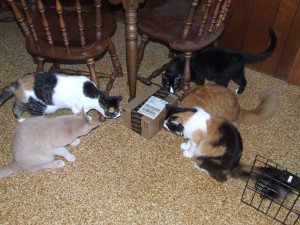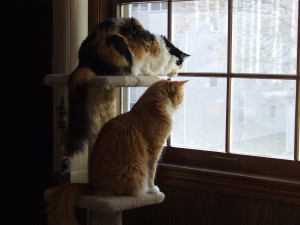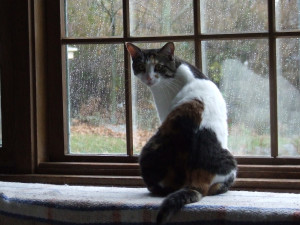Written by Tracy Dion, March 2013.
 Since its appearance in the US in the 1930′s, the pet food industry has been extraordinarily successful in its marketing campaigns, convincing an entire generation they are inherently incapable of feeding their pets without “expert” guidance and erasing over 10,000 years of evolutionary fact; to whit, cats are obligate carnivores that thrive on a raw, prey-based diet. Today, feeding raw meat, bones and organs to our beloved pets is considered a novel and dangerous concept.
Since its appearance in the US in the 1930′s, the pet food industry has been extraordinarily successful in its marketing campaigns, convincing an entire generation they are inherently incapable of feeding their pets without “expert” guidance and erasing over 10,000 years of evolutionary fact; to whit, cats are obligate carnivores that thrive on a raw, prey-based diet. Today, feeding raw meat, bones and organs to our beloved pets is considered a novel and dangerous concept.
The truth is, of course, that cats don’t just thrive on such a diet, they have a physiological need for it. Furthermore, there are raw commercial products available that meet the same AAFCO guidelines (if such is your gold standard) as traditional commercial products, and anyone willing to put a little thought and time into it can create a relatively inexpensive and balanced diet right in the convenience of their own homes. Raw is what cats are designed to eat, and feeding it can be both easy and economically feasible.
Once you decide how to source your cat’s new diet, your next step is convincing him that he prefers it over his current food.
Although each type of diet – ground, prey model and whole prey – has its own transition tricks, these four guidelines apply to any transition and will go a long way toward ensuring your efforts are successful.
Don’t Stress It.
First and foremost, don’t stress the transition. You are not in a race and unless your cat is suffering ill effects on his current diet, there is no reason to rush, nor is there is there a time limit. This is a lifestyle change for you both that might involve starts and stops and perhaps even a little backpedaling. There’s nothing wrong with that! However long it takes, however convoluted your progress may become, don’t push, don’t hover, and don’t stress.
Cats are sensitive creatures and pick up emotions easily. If you are hovering over him, shedding anxiety and begging him to just eat one bite (and I have counseled owners who have done exactly this), your cat is more likely to want to hide from whatever dire happening has you so upset than he will be to eat.
So relax. Take it easy, and enjoy each milestone as your cat learns to eat the way nature intended for him. You will be better able to manage and even enjoy his progress. I have spoken with many owners who exclaimed that despite cringing during the first few bone-in meals, the sound of their cats chomping through bone now gives them a curious sense of satisfaction; and so it will be with you.
 Let your cat set the pace.
Let your cat set the pace.
Many owners are so excited when they first learn of the benefits of raw feeding, or so appalled when they come to understand the true nature of standard commercial diets, they want their cats switched to raw overnight. This can happen, but it’s rare (except for kittens) and if you push your cat too hard, you’ll sabotage your own efforts.
Cats, just like people, have difference personalities and preferences. Whatever your cat’s unique perspective, allow him to take the transition at his pace. Some are adventurous and willing to dive right into a new food. They may take to raw in a single meal. Others are more timid and need to see and smell the new food several times before venturing a bite. Many, unfortunately, are addicted to kibble and are initially reluctant to even try anything new. Every cat is different, and every transition unique.
In addition to preferences, cats need to learn how to scissor through meat, skin, tendon and, eventually, small bones, and they need to work up the jaw strength to do so. They are easily discouraged, so it’s important to start small and slow, setting the cat up to be successful at every step. A cat that attempts to crunch through a thigh bone (which is too thick for most cats) and fails will often be reluctant to make another attempt at a bone-in meal, even when offered something as easy to break down as quail ribs.
Never try to force your cat to eat the new food. And never try to starve him into eating it, as you could cause him to become very ill within a remarkably short time.
Cats are prone to a serious and potentially fatal disease called hepatic lipidosis, or “fatty liver disease” that is brought on by starvation. It can happen in as little as 48 hours, especially if they are overweight, so don’t let your cat skip more than a couple of meals. Offer him whatever it takes to get him eating regularly again and then start the transition over at the point just before he began refusing food.
Moving at the cat’s pace will ensure he feels confident and comfortable as you move forward with the new diet.
Serve three or four scheduled meals.
One of the biggest hurdles to a successful transition is the all-you-can-eat kibble buffet served in so many feline homes. There is very little incentive for a cat that is never truly hungry to try something new.
 If you’re free-feeding, your first transition step is to accustom your cat to scheduled meals. This may mean starting with several small meals a day, but the goal is to work down to three (or four, if you can manage it).
If you’re free-feeding, your first transition step is to accustom your cat to scheduled meals. This may mean starting with several small meals a day, but the goal is to work down to three (or four, if you can manage it).
If you’re not free-feeding, but only offering one or two meals, your first transition step will make your cat very happy – you will need to add that second or third meal.
Most cat owners are unaware that meal frequency impacts their cats’ health, and there is a lot of confusion around how often a domesticated cat should be fed. The majority are either free-fed or fed only once or twice a day, despite the fact cats evolved to spend most of their time hunting and would naturally eat between 8 – 12 small meals every 24 hours.
Because it’s so important, I’m going to digress a moment here and summarize why offering at least three or four meals to adult cats (and four or five meals to kittens) is so strongly recommended.
First, smelling food triggers a cat’s digestive system to begin working, and constantly smelling food – as free-fed cats do – keeps that system primed and ready to go all day, pulling energy from other systems and, potentially causing issues like premature aging, poor coat quality, and chronic cystitis.
In addition, a carnivore’s digestive physiology has incorporated hunger as an integral part of its healthy workings. Indigestible solids are retained in the stomach until digestion of other food products is completed and it is, in fact, hunger pangs which propel this material forth. If the cat is never allowed to become hungry, the regulation of waste movement is compromised, leading to discomfort, hairball regurgitation and other digestive issues.
On the flip side, the cat’s stomach can’t expand like the dog’s to accommodate large meals, and cats can – and often do – regurgitate if fed too much at one time, as might happen with a cat fed only once or twice daily. Eating too fast, as cats tend to do when they are very hungry, can also cause discomfort and regurgitation of the meal.
Additionally, as the cat becomes hungry, the buildup of bile acids in the stomach can cause him to become nauseous, provoking what many have termed “hunger pukes.”
Finally, the frequency of a cat’s meals impacts the PH of his urine. ‘Post-prandial alkaline tide’ refers to the increase in urine alkalinity that follows the ingestion of a large meal, a PH change that can lead to the formation of painful and potentially deadly struvite crystals. Eating smaller, more frequent meals – mimicking their instinctive hunting behavior – naturally helps maintain a cat’s PH in the normal range.
It only makes sense that following the cat’s evolutionary behavior patterns as closely as possible will provide the most benefits to the cat, and offering at least three or four meals a day is a workable balance for most cats and their owners (before work, after work, and just before bed).
Be flexible, but persistent.
We all know how “finicky” cats can be, how often they change their furry little minds. During the transition, you’ll likely encounter days when your cat refuses something he ate with gusto the day before. Don’t let this discourage you. Keep offering different meats or meals. Use briberies liberally (sprinkles of freeze-dried chicken treats, etc.) on top of the food you’re offering, but don’t be afraid to take a step back to the last thing he ate, even if it means offering smaller meat chunks or less raw mixed with canned.
Some cats will take to raw after a single meal; others may take weeks or months. Kibble addicts often take several weeks. Some might run into problems with certain products or meats, such as constipation related to bone-heavy commercial blends, or intolerance to grain-fed beef and chicken meats. A few cats may do fine for several weeks after a full transition, only to suddenly run into an issue that causes you to back-pedal a bit.

Don’t let any of these delays, plateaus or problems discourage you. And above all, don’t let a recalcitrant cat make you give up. No matter how long it takes to get your feline friend to accept a raw diet, you can outwait him. Your persistence and patience will pay off in an immeasurably healthier, longer-lived and happier feline companion.
Conclusion
Although the ease and timeframe may differ, all cats can be transitioned to raw; just research and learn what tricks and tips work best with your chosen diet and combine them with the four basic tactics described here. Thousands of cat owners have already done it – and seen their cats’ health make amazing improvements – and you can too!
If you enjoyed this article or found it informative, please “Like” it, “Tweet” it, or share it using any of the buttons below. And don’t forget to check out our FB page, join the discussions in our awesome FB group and follow us on Twitter!
Created 04/28/13; Updated 08/11/14

